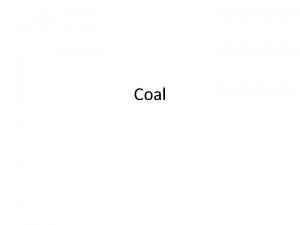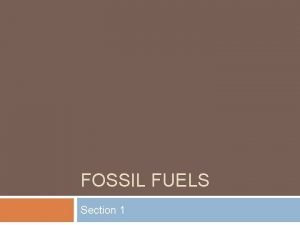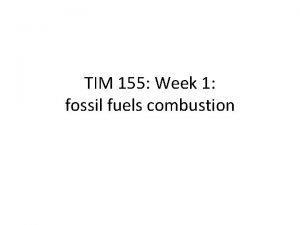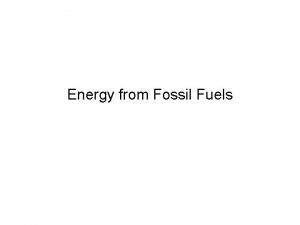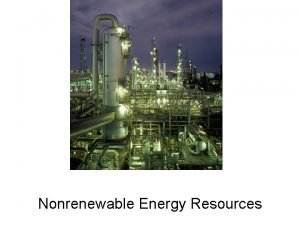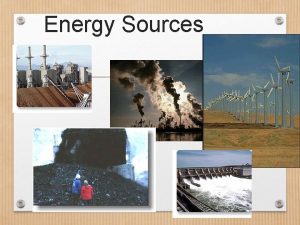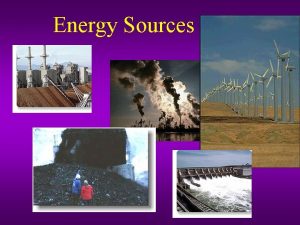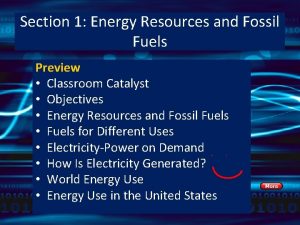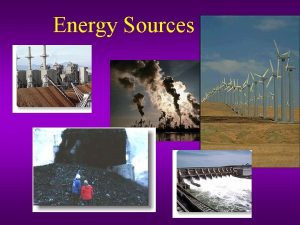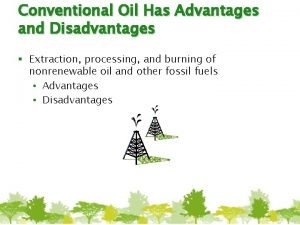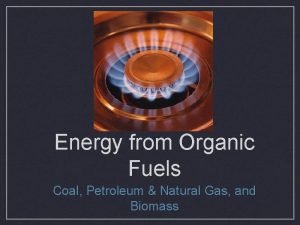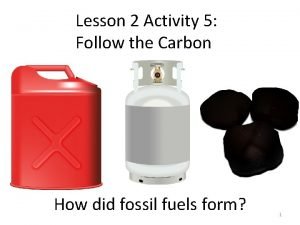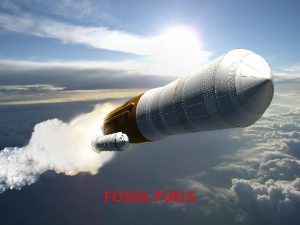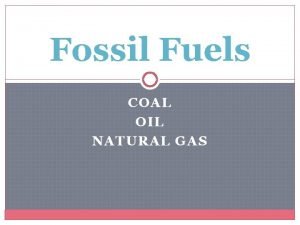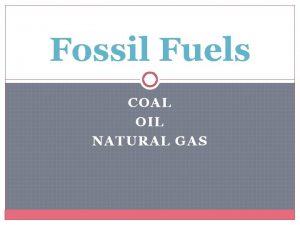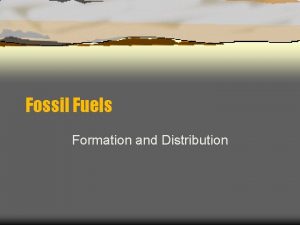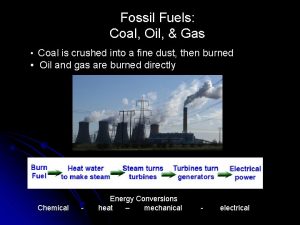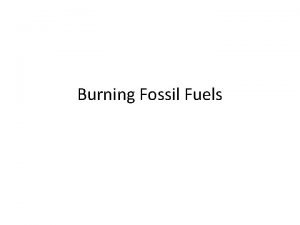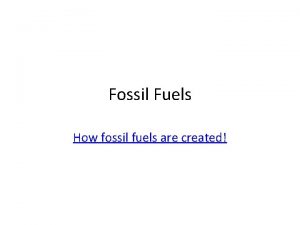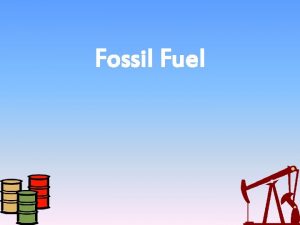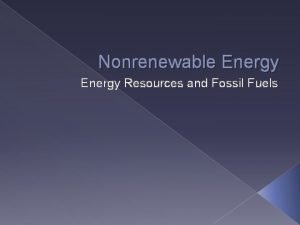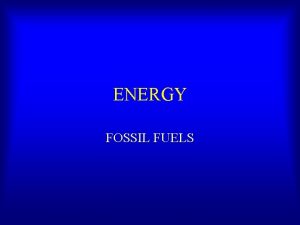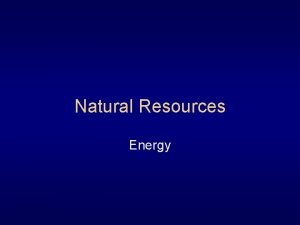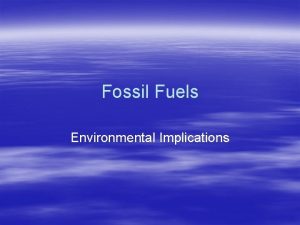Formation of Fossil Fuels Fossil Fuels Coal Oil






















- Slides: 22

Formation of Fossil Fuels

Fossil Fuels • Coal • Oil (Petroleum) • Natural Gas

Formation of Petroleum and Natural Gas • Energy came to the earth in the form of sunlight hundreds of millions of years ago. • Radiant energy was then captured by algae through photosynthesis. • Dead algae and plankton accumulated at the bottom of the ancient seas.

Formation Continued… • Accumulation continued, increasing the pressure and temperature on the underlying layers. • The result was a loss of oxygen and the formation of solid, liquid, and gaseous hydrocarbons • i. e. They were gradually buried by layers of rock which stopped them rotting • The liquid and gaseous hydrocarbons moved upward through the porous rock until reaching an impermeable layer of rock.

Migration and Concentration • Petroleum must leave source rock • Process is called migration • Migration is essential because most source rocks are too fine-grained to enable easy extraction of the oil • To be economically concentrated, petroleum must migrate to a reservoir rock with a trap

Petroleum Resources • • • Conditions for source rock are rare Conditions for maturation must be just right Migration must not let petroleum escape to surface Reservoir rock must be present Trap must exist before migration occurs

Refining of Petroleum • • • Heat and/or chemical treatment to produce: Gasoline Diesel Fuel Kerosene Liquified Propane (LPG) Petroleum bases for plastics

Distribution of Petroleum • Economic accumulations of petroleum only occur when all of these conditions are met • These conditions and the sequence of occurrence do not occur everywhere • Conditions are most likely where there are thick accumulations of sedimentary rock

Some of the world’s most productive sedimentary basins • • Saudi Arabia Kuwait Alaska – north slope Texas – Louisiana Gulf Coast Iraq and Iran Mexico Venezuela

Oil Reserves • Total world production of petroleum in 1996 was 62 million barrels per day. • A study performed in 1993 revealed that there is 1. 8 trillion barrels of oil that is economically recoverable. • At the highest expected production rates, there is an estimated 50 years of oil left.

World Oil Distribution

Geological conditions of oil formation More than 80 percent of world‘s oil are in these two belts Source: BGR, 1995

World Reserves

Coal Formation • Unlike oil and natural gas, coal formed from decaying plants in ancient swamps. • When the peat is exposed to high temperatures and pressures, it forms coal. • There are three main types of coal: anthracite, bituminous, and lignite.


Anthracite • It is the oldest and hardest form of coal. • Its carbon content is up to 95%, which means it is also the cleanest burning of the coals. • Only 1% of minable coal in the U. S. is anthracite. • Almost all anthracite is found in Pennsylvania.

Bituminous Coal • It is roughly 300 million years old, and comprised of 50% to 80% carbon. • Bituminous coal makes up 71% of the minable coal in the U. S. • It is located mainly in the Rocky Mountains and the Mississippi River Basin.

Lignite • Was formed about 150 million years ago. • It is comprised of roughly 50% carbon. • Lignite makes up 28% of minable coal in the U. S. • Mainly located in the Rocky Mountain region and the southern U. S.

World Coal Reserves

Formation of Fossil Fuels – simplified • • Burial of organic material millions of years ago Reducing conditions – little or no free oxygen Reducing conditions preserve organic matter Coal and Petroleum diverge from here

Formation of Coal • Accumulation of land plant material • Reducing conditions – coastal and inland swamps

Courtesy: • http: //www. physics. rutgers. edu/~kotliar/honors/honsem 02/somalwar/Hon Sem 02/Presentation 1. ppt • http: //employees. oneonta. edu/ebertjr/Fossil%20 Fuels. ppt • http: //www. sust. sbg. ac. at/download/sschool 02/w_zittel_oil. ppt • http: //noadswood. hants. sch. uk/noads/Noadswood_Science/Topic_(Year_7 )_-_Energy_&_Electricity_files/Fossil%20 Fuels. ppt • http: //www. chem. wwu. edu/prody/122 -10. ppt • http: //www. d. umn. edu/~pmorton/geol 2350/2007/powerpoints/Natural%2 0 Gas%20 and%20 other%20 Fossil%20 Fuels. ppt • http: //www. d. umn. edu/~pmorton/geol 2350/2007/powerpoints/Energy%2 0 quiz%20 and%20 coal. ppt
 Coal is the most abundant fossil fuel
Coal is the most abundant fossil fuel Coal is a solid fossil fuel formed from plant remains
Coal is a solid fossil fuel formed from plant remains Coal, oil
Coal, oil Coal oil
Coal oil Fossil
Fossil Fossil fuels
Fossil fuels Fossil fuels formula
Fossil fuels formula What are the environmental impacts of fossil fuels
What are the environmental impacts of fossil fuels Fossil fuels summary
Fossil fuels summary Pros cons of biomass energy
Pros cons of biomass energy Natural gas advantages
Natural gas advantages Similarities between biofuels and fossil fuels
Similarities between biofuels and fossil fuels The origin of oil student worksheet answers
The origin of oil student worksheet answers Advantages of fossil fuels
Advantages of fossil fuels Benefits of using fossil fuels
Benefits of using fossil fuels Fossil fuels deposits
Fossil fuels deposits Fossil fuels include
Fossil fuels include Advantages of using oil
Advantages of using oil Examples of electrical energy
Examples of electrical energy Coal formation
Coal formation Stages of coal formation
Stages of coal formation Formation of coal
Formation of coal Coal formation
Coal formation
